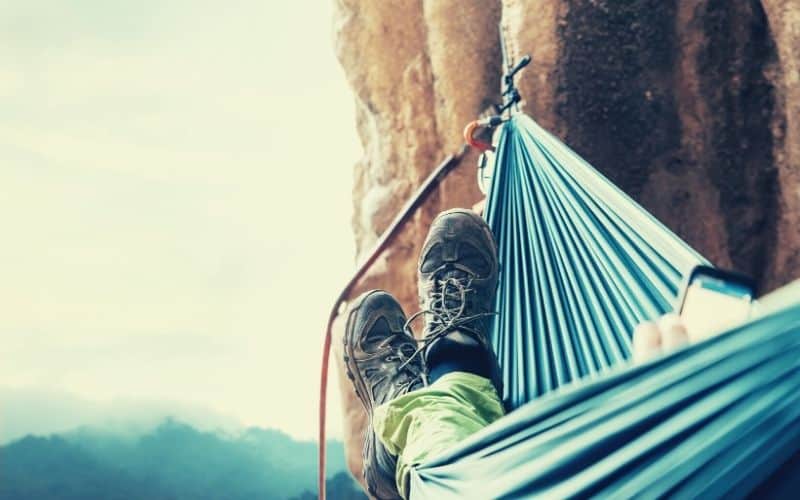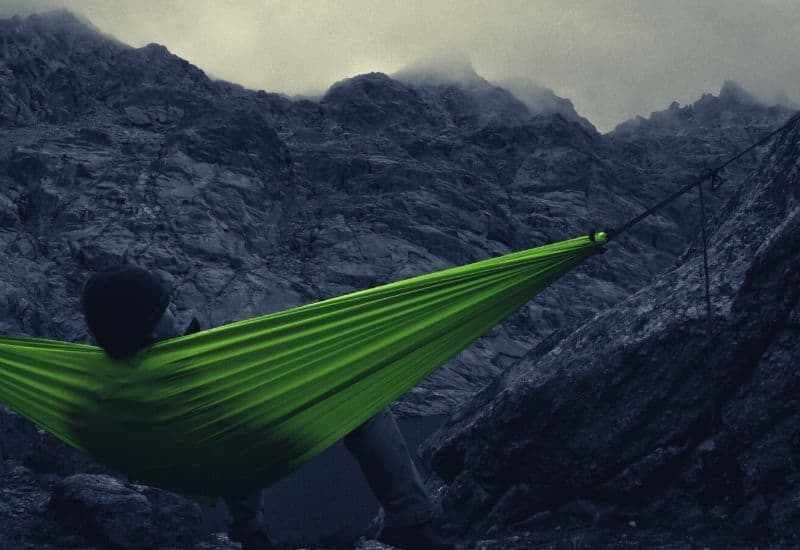Hammocking provides campers with a unique outdoor experience. However, when there are no trees around to strap your hammock to, what do you do? Whether you’re in the wild or camping at home, we have some alternative options to tree hammocking for you to try out.
In this article, we’ll explore six tree-free methods for hammocking. In the wild, consider using vehicles, portable hammock stands, or rocks. In your yard at home, you can dig in some posts, use an existing building structure, or even build a permanent hammock structure.
If all else fails, we’ll guide you on using your hammock as a tarp, so you don’t need to worry about a lack of trees on your upcoming hammocking adventures.
Do
- Select a pitching method that’s appropriate for your hammocking location
- Ensure your two anchor points are strong enough to support your weight
- Consider making a permanent hammocking structure if at home
Don’t
- Forget to test your setup before climbing inside to ensure it’s pitched properly
- Overlook being creative with your hammocking setup when there are no trees available
How to set up a hammock without trees in the Wild?
When your camping site lacks suitable trees for hanging your hammock, the following list provides useful alternative methods when out in the wild.
- Use vehicles
- Use a hammock stand
- Use rocks
1. Use Vehicles
For car camping, create a DIY car hammock stand by using your vehicle’s roof rack. Of course, doing so is only possible if your car is nearby and if you have a boulder, tree, or other structure close by to serve as a secondary anchor point.
If you’re keen to try out this method, you’ll need a car or truck with a roof rack as well as some tree straps. Tie the straps to the part of the roof rack where it attaches to your car’s roof as this reduces the overall load on your vehicle.
Then, attach one end of your hammock to your roof rack and the other to a secondary anchor point to complete your camping setup for the night.

2. Use a Hammock Stand
Portable hammock stands offer a convenient way to set up your campsite for the night when hammocking.
Hammock camping stands are available at many outdoor gear stores, so you can usually get one relatively easily. Many models are also collapsible, which makes them an ideal choice for use at the campground.
To use one of these stands, you simply need to follow the instructions and set it up in your preferred snoozing location. Once the portable hammock stand is pitched, you can attach your hammock to it using the included chains or straps. It’s as easy as that!
3. Use Rocks
If you’re hammock camping without trees, rocks serve as an ideal anchoring system. Many popular camping spots in the alpine feature massive boulders, which make for superb hammocking locations.
The good news is that hanging your hammock off of rocks is fairly straightforward.
To do so, you’ll want to make sure that your rocks are at a distance of about 10 to 18 feet apart and that they’re large enough to support your weight. This usually means searching for boulders that are at least 6 to 8 feet tall.
To pitch your hammock on rocks, you have a number of options. For example, you can opt for very long pieces of webbing or tree straps to wrap around the boulders to create anchor points.
Or, you can use pieces of climbing gear (e.g., cams and nuts) to anchor into the rock. However, if you’re going to use climbing gear for your setup, be sure to get quality instruction on how to do so properly to avoid injury.

How to put up a hammock without trees at Home?
For at-home hammocking, there are multiple ways to hang your relaxation spot without trees. The following list outlines some methods to try at home or in your backyard.
- Dig in some posts
- Attach to buildings
- Build a hammock structure
1. Dig in some Posts
If you lack solid trees in your backyard, fence posts and poles can serve as a reliable alternative for attaching a hammock to.
You can buy quality posts at nearly any hardware store for this project. But, make sure that your wooden posts have at least a 5-inch diameter and are 6 to 8 feet in height, or they won’t be able to support your weight while hammocking.
Once you’ve found an ideal hammocking spot for your hammock posts, follow these steps.
- Dig two holes into the ground for your posts. These should be about 2 feet deep, 10 to 15 feet apart, and 4 to 6 inches wide.
- Place a post in each hole and backfill the holes with concrete. Encasing your posts in concrete is essential to prevent them from failing under load.
- Wait about 12 hours for the concrete to set.
- Fix J-hooks to each post to serve as anchors.
- Tie one end of your hammock to each post and adjust the tension until you get the perfect hang.

2. Attach to Buildings
When hammocking at home, buildings can serve as excellent anchor points. Sturdy structures, such as columns, banisters, and joists, provide ideal locations for pitching your hammock.
For this method, you’ll want to head to the hardware store and invest in two J-hooks to serve as your anchors. You can bolt these J-hooks to a column and then use carabiners or chains to attach your hammocking setup.
Do note, however, that regular ol’ drywall isn’t strong enough to support your weight. If you want to use your wall as an anchor, you’ll need to use a stud finder to find the frames behind the drywall. Otherwise, you risk damaging your home (and self) in the process.

3. Build A Hammock Structure
For a more permanent hammocking setup at home, you may want to consider building a designated hammocking structure. This could range from a simple DIY stand to a more elaborate, weatherproof snoozing area.
Since there are so many different ways to create hammock structures, you can fine-tune your design to meet your space constraints and budget. If you’re looking for some ideas for your structure, you could check out this video of a DIY hammocking pergola:
The concept behind most of these hammocking structures is quite similar to creating hammocking anchors using posts. However, creating a full-fledged structure lets you take your design to the next level.
How To Use Your Hammock As A Tarp?
If all else fails, using your hammock as a tarp is always an option. Since most hammocks are made from highly water-resistant materials they can protect you from the elements in a pinch. For this method, pitch your hammock like you would a rain fly. If two trees or rocks aren’t available, sturdy trekking poles or your car can serve as alternative anchors.
One option is to hang your hammock off trekking poles that are spaced 10 feet apart and use guylines to tension it properly. At the end, you should have a makeshift A-frame tarp to keep you dry at night.
Become A Hammock Hanging Guru
At this point, you’re a veritable expert when it comes to setting up a hammock without trees. Whether you’re wild hammock camping in the backcountry or creating a peaceful napping spot in your backyard, you have plenty of viable methods to choose from.
We hope our article helped you become more confident in your hammocking abilities. If you successfully used one of these methods during your adventures, let us know in the comments below. Also, don’t forget to share this article so your friends can brush up on their hammocking skills, too!
If you want a little refresher on how to set up a hammock with tree straps, head over to our article on “How to Hang a hammock (with trees)“.

